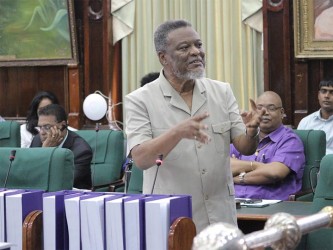Prime Minister Samuel Hinds has warned against the cutting of the proposed allocations for the Guyana Power and Light Inc (GPL), which he said are necessary for several capital investment projects.
“Let me say that the $3.850 billion capital allocated for GPL is neither a handout nor money being thrown down a black hole,” Hinds told the National Assembly during his contribution to budget debates on Tuesday.

A total of $4.350 billion is to be allocated to GPL under the government’s proposed $220 billion budget.
Explaining what the money will be used for, Hinds, who has responsibility for electricity and energy issues, said that some of the funds will be used for the completion of the transmission upgrade programme and the acquisition of equipment for a new substation at Williamsburg at Number. 53 Village, Corentyne. He said that government is happy for the opportunity to upgrade the transmission system along the Corentyne as this will ensure a better electricity supply to residents.
He said that the allocation will also be used to complete a current loss reduction programme with the Inter-American Development Bank, which includes the piloting of smart meters and hardened distribution networks; installation of additional generators at Leguan and Wakenaam so as to start a 24 hours/seven days a week electricity service, installation of two new 2MW Wartsila generating sets at Anna Regina and a new 2×2 MW station possibly at Bamford Point to meet increase demands and to remedy the evident generation shortfalls at Bartica.
Hinds told the House that if the opposition cuts the allocation, the opportunity to make the investments at a concessionary charge of about 4% will be lost; the Corentyne would be without the substations; the supply of electricity to Leguan and Wakenaam will be restricted to 16 hours per day as is the situation at present; the new generating stations at Anna Regina and Bartica will be delayed and the loss recovery programme will be suspended.
He said the government’s general aim is to provide where needed and as the budgets can carry, the first capital installation and to provide monthly a certain minimum quantity of electricity at a highly subsidized charge or no charge.
According to him electrification in Guyana “is being advanced steadily” and he noted that about 95% of homes now have some degree of electrification and about 80% of homes and other buildings are supplied by GPL, which has a customer base of 175,000.
He said the growth of customers over the last two decades is evident in the increases from 75,000 customers in 1992 to 120, 000 in 2,000 to 175,000 today.
Hinds noted that there are 12,000 customers on the Linden, Kwakwani and Ituni grids in Region Ten. Additionally, he said that there are micro grids in some Amerindian villages.
He said the $3.850 billion sum is a quantity of the money that GPL ought to be receiving from tariffs. He explained that the tariff calculation established at the time of GPL’s privatisation, which is based on international practices, sets the annual tariff adjustment for GPL at about 12%, which would provide GPL $4 billion more from this increased tariff.
Hinds admitted to the House that there have been large allocations to GPL since the core investor departed, noting that the total provided to GPL since then would have been more than $40 billion but “government, according to long tradition and practice since the early 1970s government, has been into keeping electricity charges to consumers suppressed at times by about 30%.” Hinds said that whilst government allocations to GPL have totalled over $40 billion during this period, the net foregone revenue of GPL has totaled about $27 billion.
Hinds said that GPL has grown and expanded over this period and government has had to provide financing for over 40 MW of new generation at two locations, the transmission upgrade being completed now along with some smaller investments.
Capital improvements over this period, he said, totalled over $28 billion. He added that government, as the owner, has had the responsibility to provide money for capital works. He added that government continuously looks at how GPL is doing in both the cost of providing electricity and the tariffs “we are allowing to be charged in comparison with utilities in other countries particularly across the Caribbean.”
Following the cut of the $5.2 billion government subsidy by the opposition during the consideration of the budget estimates last year April, GPL’s management had moved to increase tariffs to make up for the funding but this was later put on hold by President Donald Ramotar. GPL, in a statement, had expressed regret that as a result of funding being denied, it has no other option but to raise revenue to remain financially viable.





